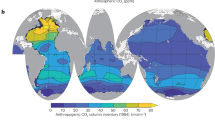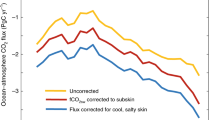Abstract
The oceans represent a significant sink for atmospheric carbon dioxide1. Variability in the strength of this sink occurs on interannual timescales, as a result of regional and basin-scale changes in the physical and biological parameters that control the flux of this greenhouse gas into and out of the surface mixed layer2,3. Here we analyse a 13-year time series of oceanic carbon dioxide measurements from station ALOHA in the subtropical North Pacific Ocean near Hawaii4, and find a significant decrease in the strength of the carbon dioxide sink over the period 1989–2001. We show that much of this reduction in sink strength can be attributed to an increase in the partial pressure of surface ocean carbon dioxide caused by excess evaporation and the accompanying concentration of solutes in the water mass. Our results suggest that carbon dioxide uptake by ocean waters can be strongly influenced by changes in regional precipitation and evaporation patterns brought on by climate variability.
This is a preview of subscription content, access via your institution
Access options
Subscribe to this journal
Receive 51 print issues and online access
$199.00 per year
only $3.90 per issue
Buy this article
- Purchase on Springer Link
- Instant access to full article PDF
Prices may be subject to local taxes which are calculated during checkout




Similar content being viewed by others
References
Siegenthaler, U. & Sarmiento, J. L. Atmospheric carbon dioxide and the ocean. Nature 365, 119–125 (1993)
Bates, N. R., Pequignet, A. C., Johnson, R. J. & Gruber, N. A short-term sink for atmospheric CO2 in subtropical mode water of the North Atlantic Ocean. Nature 420, 489–493 (2002)
Gruber, N., Keeling, C. D. & Bates, N. R. Interannual variability in the North Atlantic Ocean carbon sink. Science 298, 2374–2378 (2002)
Karl, D. M. & Lukas, R. The Hawaii Ocean Time-series (HOT) program: Background, rationale and field implementation. Deep-Sea Res. II 43, 129–156 (1996)
Wanninkhof, R. Relationship between wind speed and gas exchange over the ocean. J. Geophys. Res. 97, 7373–7382 (1992)
Winn, C. D., Mackenzie, F. T., Carrillo, C. J., Sabine, C. L. & Karl, D. M. Air-sea carbon dioxide exchange in the North Pacific Subtropical Gyre: Implications for the global carbon budget. Glob. Biogeochem. Cycles 8, 157–163 (1994)
Ishii, M. et al. Seasonal variation in total inorganic carbon and its controlling processes in surface waters of the western North Pacific subtropical gyre. Mar. Chem. 75, 17–32 (2001)
Houghton, J. T., Jenkins, G. J. & Ephraums, J. J. (eds) Climate Change: The IPCC Scientific Assessment (Cambridge Univ. Press, Cambridge, UK, 1990)
Weiss, R. F., Jahnke, R. A. & Keeling, C. D. Seasonal effects of temperature and salinity on the partial pressure of CO2 in seawater. Nature 300, 511–513 (1982)
Waple, A. M. et al. Climate assessment for 2001. Bull. Am. Meteorol. Soc. 83, S1–S62 (2002)
Minobe, S. & Nakanowatari, T. Global structure of bidecadal precipitation variability in boreal winter. Geophys. Res. Lett. 29, 1396–1399 (2002)
Lukas, R. Freshening of the upper thermocline in the North Pacific subtropical gyre associated with decadal changes in rainfall. Geophys. Res. Lett. 28, 3485–3488 (2001)
Hoerling, M. & Kumar, A. The perfect ocean for drought. Science 299, 691–694 (2003)
Dore, J. E., Brum, J. R., Tupas, L. M. & Karl, D. M. Seasonal and interannual variability in sources of nitrogen supporting export in the oligotrophic subtropical North Pacific Ocean. Limnol. Oceanogr. 47, 1595–1607 (2002)
Chavez, F. P., Ryan, J., Lluch-Cota, S. E. & Ñiquen, M. C. From anchovies to sardines and back: Multidecadal change in the Pacific Ocean. Science 299, 217–221 (2003)
DOE Handbook of Methods for the Analysis of the Various Parameters of the Carbon Dioxide System in Sea Water Version 2 (eds Dickson, A. G. & Goyet, C.) ORNL/CDIAC-74 (Carbon Dioxide Information Analysis Center, Oak Ridge National Laboratory, US Department of Energy, Oak Ridge, Tennessee, 1994)
Dickson, A. G. Reference materials for oceanic CO2 measurements. Oceanography 14, 21–22 (2001)
Lewis, E. & Wallace, D. W. R. Program Developed for CO2 System Calculations ORNL/CDIAC-105 (Carbon Dioxide Information Analysis Center, Oak Ridge National Laboratory, US Department of Energy, Oak Ridge, Tennessee, 1998)
Lueker, T. J., Dickson, A. G. & Keeling, C. D. Ocean p CO 2 calculated from dissolved inorganic carbon, alkalinity, and equations for K1 and K2: Validation based on laboratory measurements of CO2 in gas and seawater at equilibrium. Mar. Chem. 70, 105–119 (2000)
Lee, K., Millero, F. J., Byrne, R. H., Feely, R. A. & Wanninkhof, R. The recommended dissociation constants for carbonic acid in seawater. Geophys. Res. Lett. 27, 229–232 (2000)
Merbach, C., Culberson, C. H., Hawley, J. E. & Pytkowicz, R. M. Measurement of the apparent dissociation constants of carbonic acid in seawater at atmospheric pressure. Limnol. Oceanogr. 18, 897–907 (1973)
Dickson, A. G. & Millero, F. J. A comparison of the equilibrium constants for the dissociation of carbonic acid in seawater media. Deep-Sea Res. 34, 1733–1743 (1987)
Keeling, C. D. & Whorf, T. P. in Trends: A Compendium of Data on Global Change (Carbon Dioxide Information Analysis Center, Oak Ridge National Laboratory, US Department of Energy, Oak Ridge, Tennessee, 2002)
Tupas, L., et al. Hawaii Ocean Time-series Data Report 4: 1992 (SOEST Technical Report 93-14, Univ, Hawaii, 1993)
Keeling, C. D. in The Global Carbon Cycle (ed. Heimann, M.) 413–429 (NATO ASI Series, Vol. I15, Springer, Berlin, 1993)
Acknowledgements
We thank past and present HOT programme scientists and staff, seagoing support personnel and the crews of the many research vessels used to collect these data. We also thank the National Oceanic and Atmospheric Administration and the Department of Energy for access to critical meteorological and atmospheric CO2 data sets. This work was supported by the National Science Foundation.
Author information
Authors and Affiliations
Corresponding author
Ethics declarations
Competing interests
The authors declare that they have no competing financial interests.
Rights and permissions
About this article
Cite this article
Dore, J., Lukas, R., Sadler, D. et al. Climate-driven changes to the atmospheric CO2 sink in the subtropical North Pacific Ocean. Nature 424, 754–757 (2003). https://doi.org/10.1038/nature01885
Received:
Accepted:
Issue Date:
DOI: https://doi.org/10.1038/nature01885
This article is cited by
-
Present-day North Atlantic salinity constrains future warming of the Northern Hemisphere
Nature Climate Change (2023)
-
Processes Controlling the Carbonate Chemistry of Surface Seawater Along the 150°E Transect in the Northwest Pacific Ocean
Journal of Ocean University of China (2022)
-
Nanomolar phosphate supply and its recycling drive net community production in the subtropical North Pacific
Nature Communications (2021)
-
Surface Water CO2 variability in the Gulf of Mexico (1996–2017)
Scientific Reports (2020)
-
Developing nutrient criteria for the Jiulong River Estuary, Southeast China
Acta Oceanologica Sinica (2018)
Comments
By submitting a comment you agree to abide by our Terms and Community Guidelines. If you find something abusive or that does not comply with our terms or guidelines please flag it as inappropriate.



